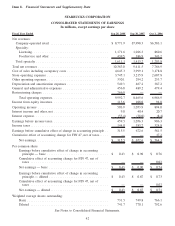Starbucks 2008 Annual Report Download - page 43
Download and view the complete annual report
Please find page 43 of the 2008 Starbucks annual report below. You can navigate through the pages in the report by either clicking on the pages listed below, or by using the keyword search tool below to find specific information within the annual report.
effect of the net change in unsettled trades from September 30, 2007 of $16.1 million. Net repayments of
commercial paper were $297.2 million and net borrowings under short term borrowings were $299.4 million for
fiscal 2008. As of September 28, 2008, a total of $713.2 million in borrowings were outstanding under the combined
commercial paper program and revolving credit facility, as well as $15.9 million in letters of credit which were
outstanding under the credit facility, leaving $270.9 million of capacity available under the $1 billion combined
commercial paper program and revolving credit facility. Partially offsetting cash used for share repurchases were
proceeds of $112.3 million from the exercise of employee stock options and the sale of the Company’s common
stock from employee stock purchase plans. As options granted are exercised, Starbucks will continue to receive
proceeds and a tax deduction, but the amount and the timing of these cash flows cannot be reliably predicted as
option holders’ decisions to exercise options will be largely driven by movements in the Company’s stock price.
The following table summarizes the Company’s contractual obligations and borrowings as of September 28, 2008,
and the timing and effect that such commitments are expected to have on the Company’s liquidity and capital
requirements in future periods (in millions):
Contractual Obligations
(1)
Total
Less than 1
Year
1-3
Years
3-5
Years
More than
5 Years
Payments Due by Period
Debt obligations
(2)
....................... $1,573.9 $ 748.4 $ 69.2 $ 68.8 $ 687.5
Operating lease obligations
(3)
............... 5,098.1 741.0 1,367.2 1,151.1 1,838.8
Purchase obligations
(4)
.................... 682.3 575.5 93.2 11.1 2.5
Other obligations
(5)
....................... 102.3 4.1 11.2 8.6 78.4
Total ................................. $7,456.6 $2,069.0 $1,540.8 $1,239.6 $2,607.2
(1)
Liabilities for incomes taxes under FIN 48 were excluded as the Company is not able to make a reasonably
reliable estimate of the amount and period of related future payments. As of September 28, 2008, the Company
had $52.6 million of gross unrecognized tax benefits under FIN 48.
(2)
Debt amounts include principal maturities and expected interest payments on commercial paper, credit facility
borrowings, and long-term debt.
(3)
Amounts include the direct lease obligations, excluding any taxes, insurance and other related expenses.
(4)
Purchase obligations include agreements to purchase goods or services that are enforceable and legally binding
on Starbucks and that specify all significant terms. Purchase obligations relate primarily to green coffee.
(5)
Other obligations include other long-term liabilities primarily consisting of asset retirement obligations, capital
lease obligations and hedging instruments.
Starbucks expects to fund these commitments primarily with operating cash flows generated in the normal course of
business, as well as ongoing borrowings under the combined commercial paper program and revolving credit
facility.
Off-Balance Sheet Arrangement
The Company’s off-balance sheet arrangements relate to certain guarantees and are detailed in Note 17 to the
consolidated financial statements in this 10-K.
COMMODITY PRICES, AVAILABILITY AND GENERAL RISK CONDITIONS
Commodity price risk represents the Company’s primary market risk, generated by its purchases of green coffee and
dairy products. The Company purchases, roasts and sells high-quality whole bean arabica coffee and related
products and risk arises from the price volatility of green coffee. In addition to coffee, the Company also purchases
significant amounts of dairy products to support the needs of its Company-operated retail stores. The price and
availability of these commodities directly impacts the Company’s results of operations and can be expected to
impact its future results of operations. For additional details see Product Supply in Item 1, as well as Risk Factors in
Item 1A of this 10-K.
37
























